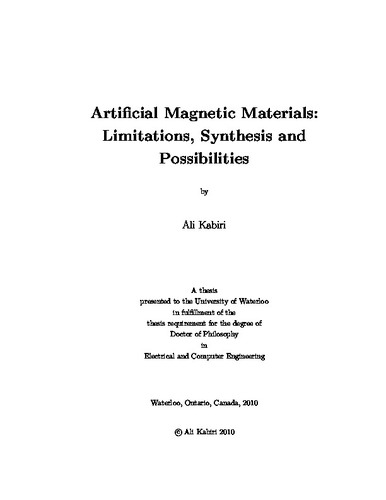Artificial Magnetic Materials: Limitations, Synthesis and Possibilities
Abstract
Artificial magnetic materials (AMMs) are a type of metamaterials which are engineered to exhibit desirable magnetic properties not found in nature. AMMs are realized by embedding electrically small metallic resonators aligned in parallel planes in a host dielectric medium. In the presence of a magnetic field, an electric current is induced on the inclusions leading to the emergence of an enhanced magnetic response inside the medium at the resonance frequency of the inclusions. AMMs with negative permeability are used to develop single negative, or double negative metamaterials. AMMs with enhanced positive permeability are used to provide magneto-dielectric materials at microwave or optical frequencies where the natural magnetic materials fail to work efficiently.
Artificial magnetic materials have proliferating applications in microwave and optical frequency region. Such applications include inversely refracting the light beam, invisibility cloaking, ultra miniaturizing and frequency bandwidth enhancing low profile antennas, planar superlensing, super-sensitive sensing, decoupling proximal high profile antennas, and enhancing solar cells efficiency, among others. AMMs have unique enabling features that allow for these important applications.
Fundamental limitations on the performance of artificial magnetic materials have been derived. The first limitation which depends on the generic model of permeability functions expresses that the frequency dispersion in an AMM is limited by the desired operational bandwidth. The other constraints are derived based on the geometrical limitations of inclusions. These limitations are calculated based on a circuit model. Therefore, a formulation for permeability and magnetic susceptibility of the media based on a circuit model is developed. The formulation is in terms of a geometrical parameter that represents the geometrical characteristics of the inclusions such as area, perimeter and curvature, and a physical parameter that represents the physical, structural and fabrication characteristics of the medium. The effect of the newly introduced parameters on the effective permeability of the medium and the magnetic loss tangent are studied. In addition, the constraints and relations are used to methodically design artificial magnetic material meeting specific operational requirements.
A novel design methodology based on an introduced analytical formulation for artificial magnetic material with desired properties is implemented. The synthesis methodology is performed in an iterative four-step algorithm. In the first step, the feasibility of the design is tested to meet the fundamental constraints. In consecutive steps, the geometrical and physical factors which are attributed to the area and perimeter of the inclusion are synthesized and calculated. An updated range of the inclusion's area and perimeter is obtained through consecutive iterations. Finally, the outcome of the iterative procedure is checked for geometrical realizability. The strategy behind the design methodology is generic and can be applied to any adopted circuit based model for AMMs.
Several generic geometries are introduced to realize any combination of geometrically realizable area and perimeter (s,l) pairs. A realizable geometry is referred to a contour that satisfies Dido's inequality. The generic geometries introduced here can be used to fabricate feasible AMMs. The novel generic geometries not only can be used to enhance magnetic properties, but also they can be configured to provide specific permeability with desired dispersion function over a certain frequency bandwidth with a maximum magnetic loss tangent. The proposed generic geometries are parametric contours with uncorrelated perimeter and area function. Geometries are configured by tuning parameters in order to possess specified perimeter and surface area. The produced contour is considered as the inclusion's shape. The inclusions are accordingly termed Rose curve resonators (RCRs), Corrugated rectangular resonators (CRRs) and Sine oval resonators (SORs). Moreover, the detailed characteristics of the RCR are studied. The RCRs are used as complementary resonators in design of the ground plane in a microstrip stop-band filter, and as the substrate in design of a miniaturized patch antenna. The performance of new designs is compared with the counterpart devices, and the advantages are discussed.
Collections
Cite this version of the work
Ali Kabiri
(2010).
Artificial Magnetic Materials: Limitations, Synthesis and Possibilities. UWSpace.
http://hdl.handle.net/10012/5579
Other formats
Related items
Showing items related by title, author, creator and subject.
-
Microwave near-field probes to detect electrically small particles
Ren, Zhao (University of Waterloo, 2013-10-22)Microwave near-field probes (MNPs) confine evanescent fields to regions that are substantially smaller than the wavelength at the operation frequency. Such probes are able to resolve subwavelength features, thus providing ... -
Cats, Rotating Waves and Photons: An Excursion into Light-Matter Interaction
Ayyash, Mohammad (University of Waterloo, 2023-09-27)This thesis hopes to achieve two modest goals. The primary goal is to formulate a practical theory for generating cat states by employing a resonant or detuned strong drive on a qubit coupled to a resonator. An incidental ... -
Theory, Design and Development of Resonance Based Biosensors in Terahertz and Millimeter-wave
Neshat, Mohammad (University of Waterloo, 2009-11-30)Recent advances in molecular biology and nanotechnology have enabled scientists to study biological systems at molecular and atomic scales. This level of sophistication demands for new technologies to emerge for providing ...

